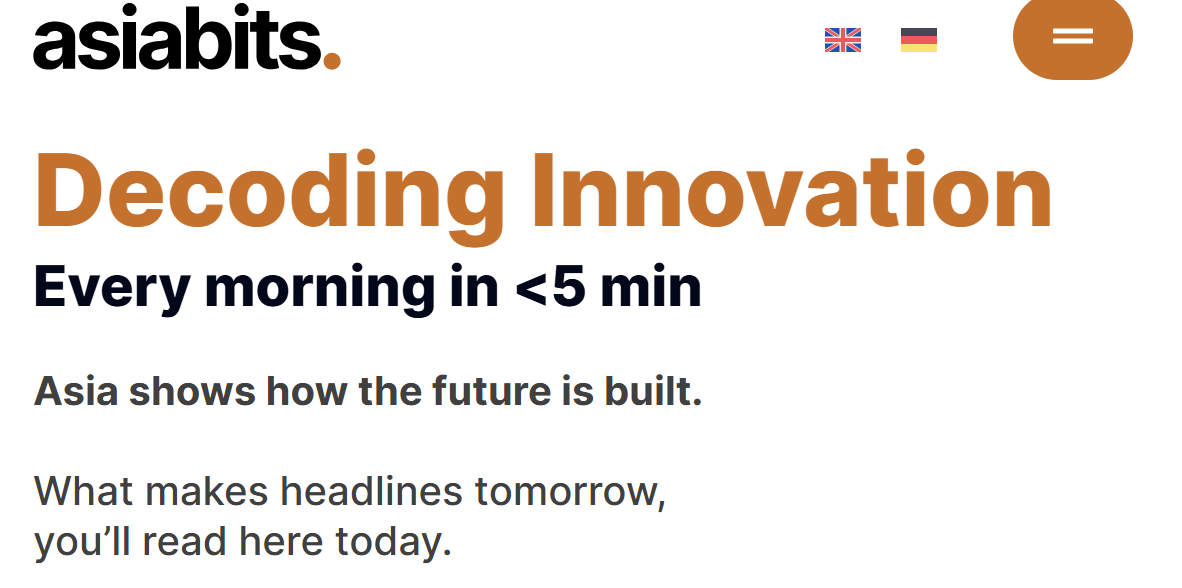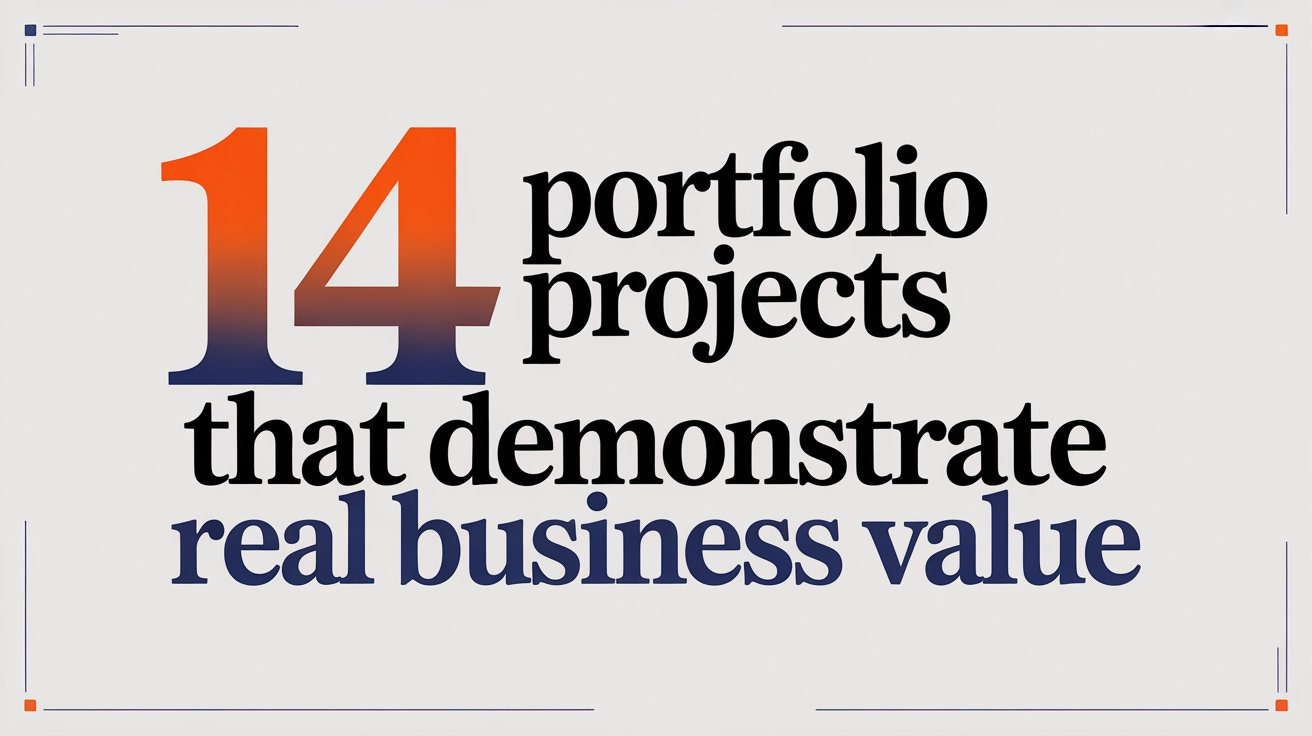14 Portfolio Projects That Demonstrate Real Business Value
Learn from these projects to improve your data career
We live in an era when data has become a commodity that every business wants to use. That’s why there are many companies willing to pay a lot of money to have the best data scientist.
With numerous competitions happening, the best way to stand out is by having data science portfolios that address real business problems with measurable results.
Below are 14 real–world–inspired projects you can take inspiration from. Each project shows the strategic problem, the approach, measurable impact, and deployment in production.
Curious about it? Let’s get into it.
Sponsored Section

Your fast-track to Asia’s hottest trends. asiabits delivers sharp insights on tech, business & culture. What the world talks about tomorrow, you read today.
1. Netflix Content Recommendation Engine
Business context: Netflix needed to keep subscribers engaged by surfacing relevant shows. Its personalization system tailors each user’s homepage.
Tech/method: A hybrid recommendation pipeline (collaborative filtering, deep learning, extensive content tagging, and ranking). Netflix tags content into ~76,000 “micro-genres” and uses multiple models to match users to content.
Metrics/results: The recommendation engine drives about 75–80% of all viewing hours. This personalization substantially boosts user engagement and retention.
Deployment: Fully embedded in Netflix’s streaming platform; served via real-time APIs to power each user’s homepage.
2. Walmart E-commerce Search Optimization
Business context: Walmart’s online store needed improved search results to boost conversions. Previously, basic keyword matches frequently showed irrelevant items.
Tech/method: Machine learning–based search ranking: deep learning and NLP models trained on billions of past search queries and user click logs. Contextual embeddings and click-through data refine the search results.
Metrics/results: After revamping with ML, Walmart saw a 20% increase in conversion rate from search traffic. In other words, far more users bought products after a search.
Deployment: Integrated into Walmart’s e-commerce platform (Walmart Labs), updating in real time as new products and queries are added.
3. Demand Forecasting & Inventory Optimization (Sam’s Club)
Business context: Sam’s Club (Walmart) needs to forecast product demand across stores and distribution centers to improve inventory, pricing, and promotions. Different teams used to create isolated forecasts.
Tech/method: A cloud-based Centralized Forecasting Service utilizing statistical and ML models (e.g., gradient boosting and recurrent neural networks) on historical sales, promotions, seasonality, and weather data. All departments share a unified forecasting pipeline.
Metrics/results: The unified system enhances forecast accuracy and consistency. More precise forecasts decrease excess stock and stockouts. For example, Walmart reported a 10% reduction in excess inventory, a 15% increase in on-shelf availability, and approximately $1 billion in holding cost savings over 12 months.
Deployment: Deployed on Google Cloud Platform, it offers automated, real-time forecasts on demand. Teams can trigger forecasts through APIs and dashboards, ensuring all decisions rely on a single source of truth.
4. Personalized Marketing & Offers (Target Guest ID System)
Business context: Target gathers both online and in-store customer data. It needed to transform this data into personalized promotions and emails to boost sales.
Tech/method: Real-time ML models that leverage a customer’s purchase history, demographics, app usage, and social sentiment. Techniques include ensemble learning for propensity scoring and multi-armed bandits for selecting email content.
Metrics/results: In 2023, Target reported that 50% of its digital sales were driven by ML-powered personalization. Personalized emails and in-app suggestions (e.g., dynamic homepage feeds) significantly boosted conversion rates and basket size.
Deployment: Models operate on Google Cloud and Kubernetes, integrated with the e-commerce front end and email marketing systems. A feature store and retraining pipelines ensure models stay updated with live loyalty and browsing data.
5. Supply Chain & Workforce Optimization (Target SCOL Project)
Business context: Beyond marketing, Target used ML in its supply chain, such as predicting local demand spikes (from events or weather) and optimizing restocking and staff schedules.
Tech/method: The Supply Chain Optimization Lab (SCOL) developed regression and time-series models using POS data, store traffic, and external data. It also employs classification to generate demand surge alerts.
Metrics/results: These ML initiatives led to notable efficiency improvements: a 12% decrease in out-of-stock items, 20% fewer overstocks, and an 18% boost in labor cost efficiency (better matching staff levels to customer demand).
Deployment: Models are deployed through Airflow and Kubeflow pipelines on Google Cloud. In production, they provide alerts to store management dashboards and automate ordering systems.
6. Gaming Hardware Recommender (Razer)
Business context: Razer’s online store serves 175 million users with a variety of gaming devices. Razer aimed to increase cross-sells and up-sells by recommending compatible products, such as suggesting a gaming mouse based on a user’s PC setup.
Tech/method: They used AWS’s Amazon Personalize (an ML recommendation service) for user segmentation and filtering. The solution was trained on user-device configurations and purchase history.
Metrics/results: This system achieved a click-through rate 10× higher than industry benchmarks, generating significant additional revenue through customized accessory recommendations.
Deployment: The model operates on Razer Synapse (their configuration utility). Recommendations are provided both in batch (via email campaigns) and in real-time (on the website), and are continuously retrained as user inventories evolve.
7. Event Recommendation Newsletter (Ticketek)
Business context: Ticketek, a live-event ticketing platform, had 4 million subscribers but only sent out state-based generic newsletters. They aimed to boost sales of smaller events like concerts and sports by matching customers with relevant shows.
Tech/method: Using Amazon Personalize, Ticketek developed a recommendation engine that factors in a user’s past purchases, browsing history, and event metadata. Every week, it produces personalized event recommendations.
Metrics/results: After the launch, the purchase rate from their newsletter tripled (up 250%), and tickets sold per newsletter opening increased by 49%. These improvements demonstrate highly targeted recommendations, increased engagement, and more sales.
Deployment: Hosted on AWS, the recommender outputs are integrated into Ticketek’s email system. Personalized newsletters are automatically generated and sent, and real-time REST APIs provide suggestions on the website as well.
8. Sports Media Personalization (Pulselive)
Business context: Pulselive, a digital partner for sports clients, needed to customize video highlights for fans of major football clubs and events. Generic video pages were not performing well.
Tech/method: Again, using Amazon Personalize, they input user clickstream and team preferences into an ML model that ranks live match clips and news items.
Metrics/results: For a leading European football client, personalized recommendations boosted video consumption by 20% across web and mobile platforms. Fans interacted more with content when it was customized to their favorite teams and topics.
Deployment: Deployed on AWS, outputs plug into the Pulselive platform. Content is delivered through a personalized video carousel on the club’s website and app, with a feedback loop for ongoing learning.
9. Fraud Detection at Scale (Mastercard)
Business context: Mastercard handles millions of transactions each minute. They needed to enhance fraud detection and cut down on false alerts to better protect merchants and cardholders.
Tech/method: Using a combination of AWS AI/ML services and graph analysis, Mastercard trains models on transaction patterns. Graph algorithms identify rings of suspicious accounts, while real-time scoring flags anomalous payments.
Metrics/results: The new system increased the detection of fraudulent transactions threefold while reducing false positives by ten times. This accuracy saves merchants billions in chargeback costs and enhances customer trust.
Deployment: The ML models operate in the cloud, processing streams of transactions. When a transaction is flagged, it’s either declined or sent for additional verification. The AI functions as part of Mastercard’s global authorization pipeline.
10. Conversational AI Chatbot (International Financial Services)
Business context: Customers need 24/7 support for routine questions like account info and policy details, but call centers were costly. The chatbot project aimed to reduce expenses and improve service speed.
Tech/method: A conversational AI built with modern NLP platforms such as Rasa, Dialogflow, or custom LLMs trained on historical support tickets. Key components include intent classification, entity extraction, and dialogue management.
Metrics/results: The bot saved €2 million annually by handling support tasks automatically. In reality, only about 6% of chats needed live agent handoff, indicating the bot’s high accuracy. Customer satisfaction also increased due to immediate responses.
Deployment: Integrated into the company’s website and mobile app, the chatbot system operates on cloud infrastructure with an orchestration layer that logs performance. Analytics dashboards monitor resolution rates and update models iteratively.
11. Route Optimization (UPS ORION)
Business context: UPS delivers 16.9 million packages daily using about 100,000 vehicles. Even small routing improvements can lead to significant savings.
Tech/method: The ORION system employs advanced combinatorial optimization and heuristics (a customized “traveling salesman” solver) for vehicle telematics and delivery data. It combines historical driver knowledge with real-time constraints.
Metrics/results: By 2016, ORION had eliminated approximately 10 million miles of driving per year, saving over 10 million gallons of fuel and roughly $300–400 million annually. UPS notes that even reducing one driver’s route by one mile a day can save about $50 million a year overall.
Deployment: ORION is integrated into UPS’s fleet management software. It creates daily optimized routes for drivers at over 1,000 facilities. Drivers get the updated routes on in-cab devices, and the system keeps learning from feedback.
12. Data Center Cooling Optimization (Google DeepMind)
Business context: Data centers use a lot of power for cooling. Even Google’s very efficient facilities gain small improvements in PUE (power usage efficiency). Cutting down energy consumption lowers operational costs and reduces carbon footprint.
Tech/method: DeepMind developed an ensemble of deep neural networks to forecast future PUE and data center temperatures. A controller model then suggests setpoint adjustments. The system was trained using historical operating data.
Metrics/results: In live A/B tests, the AI controller reduced cooling costs by 40% while maintaining all systems' safety. For Google, this resulted in millions of dollars in savings and a notable decrease in emissions.
Deployment: The model operates within Google’s data center management software. It continually processes real-time sensor data (via Dataflow/Flink), predicts results, and independently fine-tunes equipment like chillers and fans.
13. Centralized Retail Forecast Platform (Walmart Sam’s Club)
Business context: Previously, different teams at Walmart (pricing, marketing, supply chain) each ran separate demand forecasts, leading to inconsistent planning.
Tech/method: Sam’s Club developed a centralized forecasting service on Google Cloud where any team can request forecasts. It uses standardized ML pipelines and trusted feature sets, ensuring all forecasts share the same data and models.
Metrics/results: Centralization significantly enhanced the consistency and speed of forecasting. By utilizing shared, audited datasets and models, teams coordinated strategies and minimized redundant efforts. The system reduces overhead and accelerates decision-making; indirectly, it also lowers inventory risk and manual workload.
Deployment: A cloud-hosted API where users submit parameters (region, SKU, time window). The backend runs time-series ML models and returns predictions. This service spans merchandising, finance, and operations.
14. AI Visual Inspection in Manufacturing
Business context: Manufacturers require near-perfect defect detection. Manual inspection is prone to errors and slow, especially for critical products like steel slabs or components.
Tech/method: Deep learning computer vision models (CNNs) analyze images from high-resolution cameras on the production line. Trained on labeled defect/no-defect samples, the system detects cracks, dents, misalignments, and more.
Metrics/results: In a steel mill case, accuracy improved from about 70% (manual) to over 98% defect detection. Precision reached 99.8%. The AI saved over $2 million annually, with a 1900% ROI in the first year. Across various examples, factories report approximately 28% less downtime and a 15–20% reduction in costs from deploying AI inspection.
Deployment: Cameras and edge processors are installed along the production line. The vision models operate in real time, displaying defects on an operator dashboard. Integration with MES/ERP systems automatically triggers hold or rework workflows. Continuous retraining addresses new defect types.
These are 14 different projects grounded in real-world applications with clear strategic value. I hope it becomes an inspiration for your personal data science project.
Like this article? Don’t forget to share and comment.



